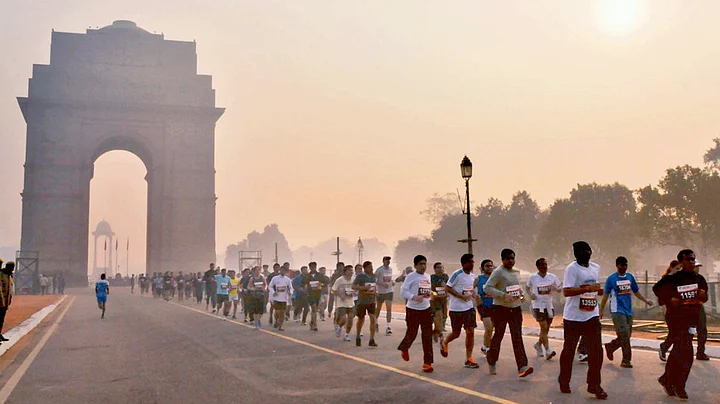Whether the smog-monster serpent of the year, Delhi, will pose any serious risk to the lungs of the 34,000 participants of the Airtel Delhi Half Marathon will be seen on Sunday, 20 November.
Though the visibility and particulate matter have improved from the alarming levels of 400-500 of last fortnight, at the time of writing the story, the air quality index still reads at a hazardous 285. The safe limit set by the World Health Organisation is 50.
A scary reminder: 6 runners and a race official suffered heart attacks in Beijing’s 2015 annual marathon, all before the finish line – it was held when the air quality index was 175.
Should the Delhi smogathon have been cancelled or pushed to another date when the weather forecast doesn’t include a lung-percolating, acrid hue? Perhaps. But that’s not happening, so what should you do? Scroll below to know the expert advice on who should duck, bob or weave through Sunday’s much-anticipated event.
Delhi’s Smogathon: Should You Be Deterred By the Foul Air?
Last year, after Beijing’s 34th International Marathon, the World Health Organisation’s China head, Dr Bernhard Schwartlander said he regretted not warning runners before the event: “Don’t run. The WHO cannot recommend anyone run in that air.”
If you are asthmatic, suffer from bronchitis or heart blockages then avoid the marathon in the present polluted circumstances. If you really have to participate, then buy a good quality air filter mask and if you feel any heaviness in the chest, irritation in breathing, breathlessness – then stop midway and seek medical help at a registered kiosk.Dr Nilesh Gautam, Head of Department, Preventive and Interventional Cardiology, Asian Heart Institute
Here’s What Happens When You Run In a Smog-Filled City
1. Your throat begins to feel sticky.
Experts say this sticky, icky feeling is the result of your lungs working harder and blood flowing faster due to heavy exertion and your lungs inhaling tiny pollution particles.
2. Breathing the toxic PM 2.5 laced smog will shorten your life.
Breathing particulate matter above healthy levels on any given day reduces your lifespan by eight hours, this is without accounting the extreme exertion of a marathon, which makes the risk much greater.
When you’re running, you breathe air much deeper – research suggests that during a marathon you will breathe as much air as a sedentary person would over two days. Imagine the amount of pollutants percolating your lungs.
3. Smg can cause heart-attack-like conditions.
The fine particulate matter can go past the nasal hair, your body’s first line of defense, and settle in the lungs. These highly dangerous, toxic particles can cause inflammation and irritation – some even bypass the lungs to get absorbed into the blood.
No one is sure exactly how particulate matter causes heart attacks, one explanation which scientists offer is that these noxious pollution particles don’t act alone – they attach themselves to heavy metals and other toxins in the bloodstream. These hitchhike into the heart can clog arteries, reduce oxygen levels in the blood, creating the perfect condition for a heart attack.
So the risk from one marathon could be little but the cumulative risk of living and breathing through this metallic haze would not be.
4. Carbon monoxide is a real blood sucker, so wear a filter... but it’s not easy to run in a mask either.
Scientists have found that in Beijing and Los Angeles, the two cities notorious for noxious air, up to 10% of marathoners have blood cells overwhelmed by carbon monoxide – this can alter muscle co-ordination.
The medical advice is to wear a mask but it’s not easy to wear heavy-duty equipment and run. Masks aren’t designed for running and breathing at the same time.
Related Read: Your 8-Point Guide to Surviving Delhi's Deadly Pollution
The final word then?
If you are participating, ensure proper hydration. Stock up on bananas and energy bars, you’re bound to wear out more in smoggy conditions than in clear weather. If any cough, wheezing or irritation persists after the marathon, go to a specialist. If you can’t run in a mask, even a handkerchief helps in blocking some pollutants.Dr Nilesh Gautam, Head of Department, Preventive and Interventional Cardiology, Asian Heart Institute
Thank your stars Delhi peeps, the airpocalypse advice is only to mask up. If there was an Ebola scare, you’d have to rent out a full Hazmat suit.
(At The Quint, we question everything. Play an active role in shaping our journalism by becoming a member today.)
